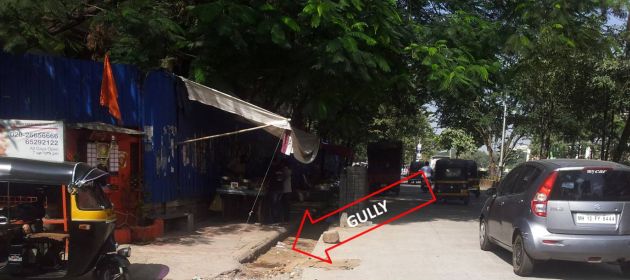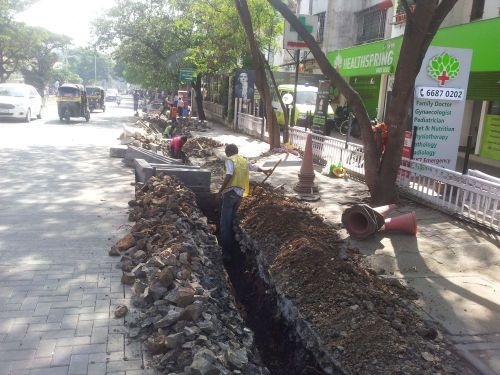The asphalt road outside my house was getting concreted last year.
When I was walking down on the road one day, I noticed that a narrow gully of around two feet width was left untouched on one side of road.
When I saw this, I thought there was a massive goof-up somwhere. In all probability, so went my cynical thinking, Pune Municipal Corporation – the local authority that is responsible for all public works in the city – must have placed an order for concreting of 100 feet width whereas the road construction contractor might have found out while executing the order that the actual width was 102 feet, hence the two feet strip went unconcreted.
Life went on and I forgot about this over time.
Until I saw the gully being dug up a month or so later.
From one of the workmen, I found out that the gang was laying a natural gas pipeline. This is pursuant to replacement of LPG cooking gas cylinders by piped compressed natural gas (CNG) in certain parts of Western India including the city of Pune where I live.
In the good old days, the road contractor would concrete the entire road and go away. The pipeline contractor would come a month later and dig up the brand new road.
And not just in Pune / India. As Janette Sadik-Khan, ex-Commissioner of New York City Transport Department, says in her foreword to the New York City Department of Transportation Streetworks Manual:
Nearly every New Yorker seems to have a story about a work crew digging up a freshly surfaced city street.
Whereas what possibly happened this time was, the road contractor was instructed to leave the gully unconcreted for the gas pipeline contractor to lay the pipe a month later. Far from being the goof-up that I suspected, this reflects solid coordination between these two contractors.
The UK government has invested hundreds of millions of pounds in streetworks regulation, processes and technology to achieve this kind of coordination between different “public utilities” that excavate city streets for laying various types of piping, cabling, etc. The specific feature that prevents repetitive digging of the same stretch of a road one after the other by two different utilities is called “pinchpoint avoidance“. As far as I know, the local authority in Pune doesn’t have such a software. Despite that, it has achieved this favorable outcome.
This is very impressive.
And it’s not an isolated incident. There are many other instances where government / public sector organizations are using technology to deliver superior citizen / customer experience without spending too much time or money:
- A friend went to the passport office to renew his passport. By the time he reached back home around 45 minutes later, he got an SMS saying his passport had already gone for printing and lamination. Sure enough, he got the renewed passport the next evening.
- Indian Railways provides very responsive service on Twitter. More on this in my blog post entitled Why Social Media Has Become My First Port Of Call For Customer Service. I believe that this initiative by @RailMinIndia is handled by a team of around 20 people aided by a few open-source sentiment analysis tools. This is an amazing feat, given the huge network size, massive volumes, 24/7/365 operations and ultrafast response times.
- The demonetization of high value currency notes in November 2016 caused a severe cash crunch in India during the last two months of 2016. The government began promoting digital payments to replace cash. In response, many banks released A2A mobile payment apps based on Universal Payment Interface (UPI), the payment system launched by the nation’s retail payments body National Payments Corporation of India (NPCI) a few months earlier. Within days, there was a proliferation of UPI apps – at peak, a Play Store search for “UPI” yielded 23 apps. The average citizen was thoroughly confused about which UPI app they should download. Realizing that the chaos could torpedo #CashlessIndia – the Twitter hashtag for the move to digital payments in India – NPCI swung into action and released a single UPI app. Called BHIM, the app could be linked to accounts in any one of dozens of participating banks. Customers of all banks now got one single UPI app to download, install and use. End of confusion. Start of adoption. BHIM was launched in barely 45 days. For comparison, development of the equivalent PayM app in UK took almost a year.
Bugs and all, @NPCI_BHIM app is a miracle in s/w dev. Similar apps in developed nations have taken months to develop & cost millions.
— GTM360 (@GTM360) January 6, 2017
I’m convinced by these events that some kind of digital revolution is going on behind the scenes. As my aforementioned friend said, it looks like government agencies are achieving a lot by reengineering their backend for a small cost.
I call this “frugal engineering“.
IT product and services companies in India have traditionally clamored for “frugal marketing”.
Well, it’s now time for them to embrace frugal engineering.
Huge software companies are today challenged by apps built by nimble companies of 40 people, that don't even need an own server to run.
— vadakkus (@vadakkus) November 9, 2016
That said, mere reengineering of the backend can drive adoption only of government systems where users – citizens, employees of government agencies, local authorities and public utilities and others – are compelled to use the systems regardless of the seamlessness of the frontend and the overall user experience.
For commercial systems, adoption requires true digital transformation, which combines the latest in forms, social, mobility, analytics and AI technologies with best practices in UI, UX and CX.
On that count, there’s a lot of scope for improvement in many applications, as I’d pointed out in the Redefine Digital section of Indian IT – Turning Crisis Into Opportunity: Part 2.
To achieve the desired end state, a lot of work needs to be done around usability, uptime, education and marketing. I doubt if that will happen with a frugal approach but only time will tell.



